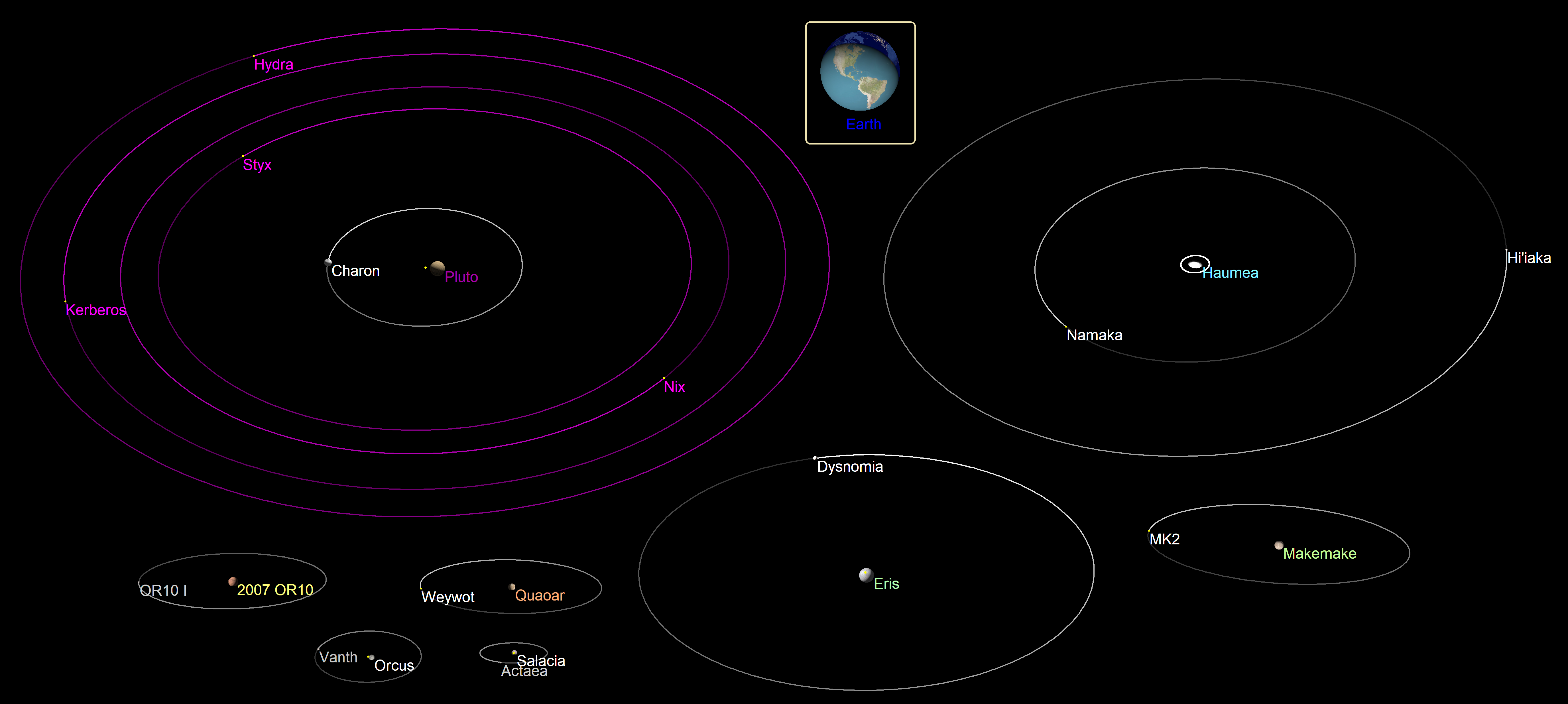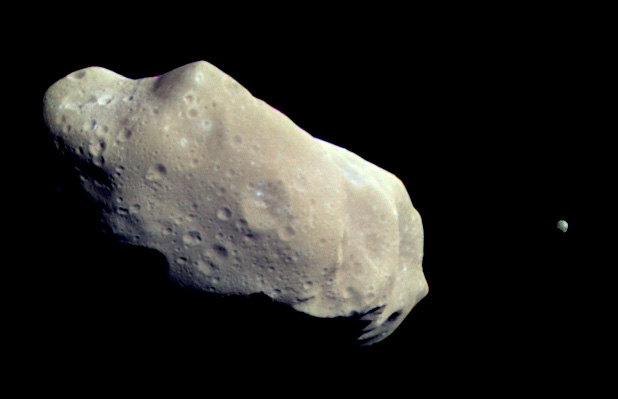|
Minor Planet Moon
A minor-planet moon is an astronomical object that orbits a minor planet as its natural satellite. , there are 457 minor planets known or suspected to have moons. Discoveries of minor-planet moons (and binary objects, in general) are important because the determination of their orbits provides estimates on the mass and density of the primary, allowing insights into their physical properties that are generally not otherwise accessible. Several of the moons are quite large compared to their primaries: 90 Antiope, Mors–Somnus and Sila–Nunam (95%), Patroclus–Menoetius, Altjira and Lempo–Hiisi (90%, with Lempo–Paha at 50%). The largest known minor-planet moon in ''absolute'' size is Pluto's largest moon Charon, which itself has about half the diameter of Pluto. The first modern era mention of the possibility of an asteroid satellite was in connection with an occultation of the bright star Gamma Ceti by the asteroid 6 Hebe in 1977. The observer ... [...More Info...] [...Related Items...] OR: [Wikipedia] [Google] [Baidu] |
243 Ida
Ida, minor planet designation 243 Ida, is an asteroid in the Koronis family of the asteroid belt. It was discovered on 29 September 1884 by Austrian astronomer Johann Palisa at Vienna Observatory and named after a nymph from Greek mythology. Later telescopic observations categorized Ida as an S-type asteroid, the most numerous type in the inner asteroid belt. On 28 August 1993, Ida was visited by the uncrewed ''Galileo'' spacecraft while en route to Jupiter. It was the second asteroid visited by a spacecraft and the first found to have a natural satellite. Ida's orbit lies between the planets Mars and Jupiter, like all main-belt asteroids. Its orbital period is 4.84 years, and its rotation period is 4.63 hours. Ida has an average diameter of . It is irregularly shaped and elongated, apparently composed of two large objects connected together. Its surface is one of the most heavily cratered in the Solar System, featuring a wide variety of crater sizes and ages. Ida's moon Dact ... [...More Info...] [...Related Items...] OR: [Wikipedia] [Google] [Baidu] |
Charon (moon)
Charon ( or ), known as (134340) Pluto I, is the largest of the five known natural satellites of the dwarf planet Pluto. It has a mean radius of . Charon is the sixth-largest known trans-Neptunian object after Pluto, Eris, Haumea, Makemake and Gonggong. It was discovered in 1978 at the United States Naval Observatory in Washington, D.C., using photographic plates taken at the United States Naval Observatory Flagstaff Station (NOFS). With half the diameter and one eighth the mass of Pluto, Charon is a very large moon in comparison to its parent body. Its gravitational influence is such that the barycenter of the Plutonian system lies outside Pluto, and the two bodies are tidally locked to each other. The reddish-brown cap of the north pole of Charon is composed of tholins, organic macromolecules that may be essential ingredients of life. These tholins were produced from methane, nitrogen and related gases which may have been released by cryovolcanic eruptions on the moon, o ... [...More Info...] [...Related Items...] OR: [Wikipedia] [Google] [Baidu] |
532 Herculina
532 Herculina is a large asteroid, with a diameter of around 200 km. Discovery It was discovered on April 20, 1904, by Max Wolf in Heidelberg, and initially catalogued as 1904 NY. The origin of its name is not known; it may be named after the mythical Hercules, given a feminine form as were all asteroids at the time, or after an unknown woman of that name. The bulk of the asteroids discovered by Wolf around this date were named for characters in operas, but if this name was also drawn from such a source, no explanation has been recorded. Physical characteristics Herculina is one of the larger members of the main asteroid belt. It is believed to rank among the top 20 in size, but the exact dimensions of many large asteroids are still uncertain. The current estimate for its mass would rank it close to the top 10. It has often been noted for its complex lightcurves, which made determination of its shape and rotation somewhat difficult. A set of 1982 speckle interferometr ... [...More Info...] [...Related Items...] OR: [Wikipedia] [Google] [Baidu] |
Asteroid Occultation
An occultation is an event that occurs when one object is hidden from the observer by another object that passes between them. The term is often used in astronomy, but can also refer to any situation in which an object in the foreground blocks from view (occults) an object in the background. In this general sense, occultation applies to the visual scene observed from low-flying aircraft (or computer-generated imagery) when foreground objects obscure distant objects dynamically, as the scene changes over time. If the closer body does not entirely conceal the farther one, the event is called a ''transit''. Both transit and occultation may be referred to generally as ''occlusion''; and if a shadow is cast onto the observer, it is called an eclipse. The symbol for an occultation, and especially a solar eclipse, is file:Occultation symbol.svg (U+1F775 🝵). Occultations by the Moon The term occultation is most frequently used to describe lunar occultations, those relatively ... [...More Info...] [...Related Items...] OR: [Wikipedia] [Google] [Baidu] |
Outer Solar System
The Solar SystemCapitalization of the name varies. The International Astronomical Union, the authoritative body regarding astronomical nomenclature, specifies capitalizing the names of all individual astronomical objects but uses mixed "Solar System" and "solar system" structures in theinaming guidelines document. The name is commonly rendered in lower case ('solar system'), as, for example, in the ''Oxford English Dictionary'' an''Merriam-Webster's 11th Collegiate Dictionary''. is the gravitationally bound system of the Sun and the objects that orbit it. It formed 4.6 billion years ago from the gravitational collapse of a giant interstellar molecular cloud. The vast majority (99.86%) of the system's mass is in the Sun, with most of the remaining mass contained in the planet Jupiter. The four inner system planets—Mercury, Venus, Earth and Mars—are terrestrial planets, being composed primarily of rock and metal. The four giant planets of the outer system are substant ... [...More Info...] [...Related Items...] OR: [Wikipedia] [Google] [Baidu] |
Hubble Space Telescope
The Hubble Space Telescope (often referred to as HST or Hubble) is a space telescope that was launched into low Earth orbit in 1990 and remains in operation. It was not the first space telescope, but it is one of the largest and most versatile, renowned both as a vital research tool and as a public relations boon for astronomy. The Hubble telescope is named after astronomer Edwin Hubble and is one of NASA's Great Observatories. The Space Telescope Science Institute (STScI) selects Hubble's targets and processes the resulting data, while the Goddard Space Flight Center (GSFC) controls the spacecraft. Hubble features a mirror, and its five main instruments observe in the ultraviolet, visible, and near-infrared regions of the electromagnetic spectrum. Hubble's orbit outside the distortion of Earth's atmosphere allows it to capture extremely high-resolution images with substantially lower background light than ground-based telescopes. It has recorded some of the most detaile ... [...More Info...] [...Related Items...] OR: [Wikipedia] [Google] [Baidu] |
Binary Asteroid
A binary asteroid is a system of two asteroids orbiting their common barycenter. The binary nature of 243 Ida was discovered when the Galileo spacecraft flew by the asteroid in 1993. Since then numerous binary asteroids and several triple asteroids have been detected. The mass ratio of the two components – called the "primary" and "secondary" of a binary system – is an important characteristic. Most binary asteroids have a large mass ratio, i.e. a relatively small satellite in orbit around the main component. Systems with a small minor-planet moon – also called "companion" or simply "satellite" – include 87 Sylvia, 107 Camilla, 45 Eugenia, 121 Hermione, 130 Elektra, 22 Kalliope, 283 Emma, 379 Huenna, 243 Ida and 4337 Arecibo (in order of decreasing primary size). Some binary systems have a mass ratio near unity, i.e., two components of similar mass. They include 90 Antiope, , and 69230 Hermes, with average compo ... [...More Info...] [...Related Items...] OR: [Wikipedia] [Google] [Baidu] |
Minor Planet Center
The Minor Planet Center (MPC) is the official body for observing and reporting on minor planets under the auspices of the International Astronomical Union (IAU). Founded in 1947, it operates at the Smithsonian Astrophysical Observatory. Function The Minor Planet Center is the official worldwide organization in charge of collecting observational data for minor planets (such as asteroids), calculating their orbits and publishing this information via the '' Minor Planet Circulars''. Under the auspices of the International Astronomical Union (IAU), it operates at the Smithsonian Astrophysical Observatory, which is part of the Center for Astrophysics along with the Harvard College Observatory. The MPC runs a number of free online services for observers to assist them in observing minor planets and comets. The complete catalogue of minor planet orbits (sometimes referred to as the "Minor Planet Catalogue") may also be freely downloaded. In addition to astrometric data, the MPC collect ... [...More Info...] [...Related Items...] OR: [Wikipedia] [Google] [Baidu] |
Rings Of Chiron
2060 Chiron is a small Solar System body in the outer Solar System, orbiting the Sun between Saturn and Uranus. Discovered in 1977 by Charles Kowal, it was the first-identified member of a new class of objects now known as centaurs—bodies orbiting between the asteroid belt and the Kuiper belt.944 Hidalgo, discovered in 1920, also fits this definition, but was not identified as belonging to a distinct population. Although it was initially called an asteroid and classified only as a minor planet with the designation "2060 Chiron", in 1989 it was found to exhibit behavior typical of a comet. Today it is classified as both a minor planet and a comet, and is accordingly also known by the cometary designation 95P/Chiron. Chiron is named after the centaur Chiron in Greek mythology. History Discovery Chiron was discovered on 1 November 1977 by Charles Kowal from images taken on 18 October at Palomar Observatory. It was given the temporary designation of . It was found near aphe ... [...More Info...] [...Related Items...] OR: [Wikipedia] [Google] [Baidu] |
Rings Of Chariklo
The minor planet and Centaur (astronomy), centaur 10199 Chariklo, with a diameter of about , is the smallest celestial object with confirmed rings and the fifth ringed celestial object discovered in the Solar System, after the Gas giant, gas giants and Ice giant, ice giants. Orbiting Chariklo is a bright Planetary ring, ring system consisting of two narrow and dense bands, 6–7 km (4 mi) and 2–4 km (2 mi) wide, separated by a gap of . The rings orbit at distances of about from the centre of Chariklo, a thousandth the distance between Earth and the Moon. The discovery was made by a team of astronomers using ten telescopes at various locations in Argentina, Brazil, Chile and Uruguay in South America during observation of a stellar occultation on 3 June 2013, and was announced on 26 March 2014. The existence of a ring system around a minor planet was unexpected because it had been thought that rings could only be stable around much more massive bodies. Ring sy ... [...More Info...] [...Related Items...] OR: [Wikipedia] [Google] [Baidu] |
Ring System
A ring system is a disc or ring, orbiting an astronomical object, that is composed of solid material such as dust and moonlets, and is a common component of satellite systems around giant planets. A ring system around a planet is also known as a planetary ring system. The most prominent and most famous planetary rings in the Solar System are those around Saturn, but the other three giant planets (Jupiter, Uranus, and Neptune) also have ring systems. Recent evidence suggests that ring systems may also be found around other types of astronomical objects, including minor planets, moons, and brown dwarfs, and as well, the interplanetary spaces between planets such as Venus and Mercury. Ring systems of planets There are three ways that thicker planetary rings have been proposed to have formed: from material of the protoplanetary disk that was within the Roche limit of the planet and thus could not coalesce to form moons, from the debris of a moon that was disrupted by a large ... [...More Info...] [...Related Items...] OR: [Wikipedia] [Google] [Baidu] |
Victoria, Texas
Victoria is a small city in South Texas and county seat of Victoria County, Texas. The population was 65,534 as of the 2020 census. The three counties of the Victoria Metropolitan Statistical Area had a population of 111,163 as of the 2000 census. Its elevation is . Victoria is located 30 miles inland from the Gulf of Mexico. Victoria is a two-hour drive from Corpus Christi, Houston, San Antonio, and Austin. Victoria is named for General Guadalupe Victoria, who became the first president of independent Mexico. Victoria is the cathedral city of the Roman Catholic Diocese of Victoria in Texas. History The city of Guadalupe Victoria was founded in 1824 by Martín De León, a Mexican empresario, in honor of Guadalupe Victoria, the first President of the Republic of Mexico. Victoria was initially part of De León's Colony, which had been founded that same year. By 1834, the town had a population of approximately 300. During the Texas Revolution, Guadalupe Victoria contributed ... [...More Info...] [...Related Items...] OR: [Wikipedia] [Google] [Baidu] |








.jpg)
